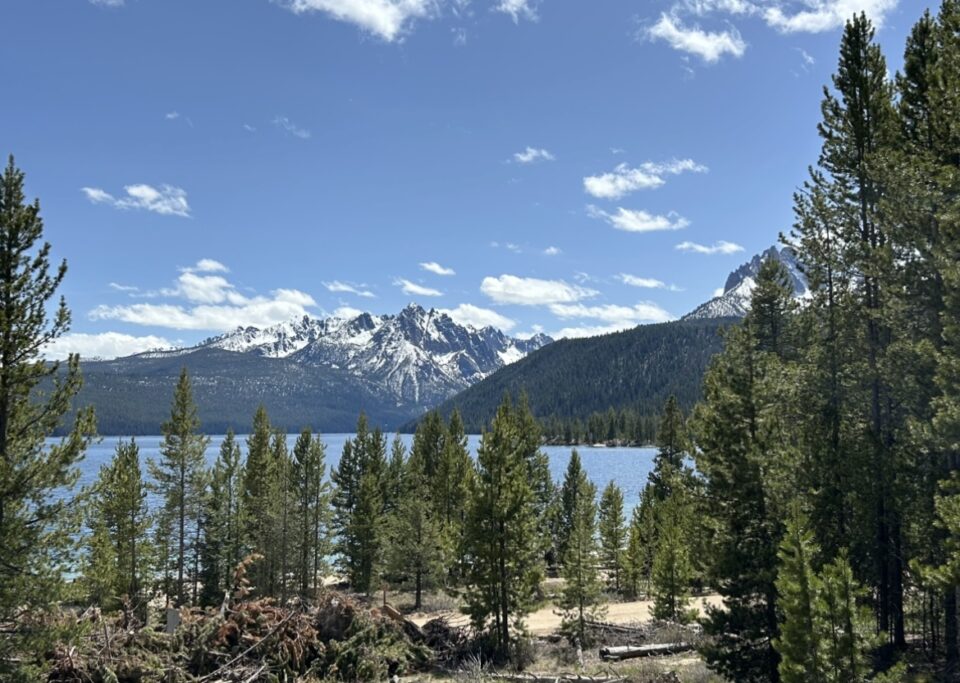The Alpine Examiner
August 4, 2024
Naturalist Blog
Getting to the heart of what matters in the Sawtooth National Recreation Area
Sawtooth Salmon Scoop
Will future generations who visit the Sawtooths be able to see salmon, an iconic fish, in their natural habitat?
Currently, the outlook is grim.
Four species of Salmon call our local waterways home; Chinook, Sockeye, Kokanee, and Steelhead Trout. (The Steelhead Trout was once thought to be in the same family as trout, but scientists have uncovered that they share more ancestral lineage with Salmon. They have since been reclassified into the Salmonid family, but have retained their common name.) The Kokanee are a landlocked species of fish, so they do not travel out to the ocean. The Chinook, Sockeye, and Steelhead Trout are born in our local waterways, travel over 900 miles to the ocean, and then make that same journey back to the Redfish area to spawn. Within that journey, the fish have to navigate through eight dams and deal with an approximate 7,000-foot elevation difference.

View of Redfish Lake from Redfish Visitor Center. Photo credit: Jenna Downing, SIHA
How on Earth do the fish figure out where “home” is? Scientists don’t fully have an answer to that. Currently, what we do know is that the fish seem to have a magnetic sense and use the water’s chemistry to determine what river branch to take to get back to where they were born. When it is time for smolts (aka baby salmon) to begin their travels, they actually float tail-first because their natural instinct is to swim against the current. This is a great way for them to conserve energy and survive… if the environment cooperates. Salmon love cold, fast-moving water. If we have a season of low snowpack, like in 2024, the water is not going to run as fast or as strong as it needs to for the smolts to reach the ocean in a timely manner. Back in the 1980s-1990s, the journey to the ocean only took about four days. Now in the 2020s, it takes about three to five weeks to get there. This means that the entire lifespan of the fish is thrown out for a loop and they are maturing too fast.

Aerial view of a dam along the Columbia/Snake River that Salmon must travel through on the journey out to the ocean. Photo credit: Jenna Downing
In addition to this, we are also noticing the effects of Earth’s average temperature steadily rising which is causing the temperatures in the waterways to increase. Eight dams along the Columbian and Snake Rivers have turned this waterway into one large reservoir system. These dams are not located directly in Idaho but are causing extreme effects on the Idaho return rate of Salmon. As mentioned earlier, Salmon require fast cold water to survive. Reservoirs are just the opposite. There is little to no current and the temperature easily rises in the slow-moving water. Because of this, the fish become disoriented and start swimming in circles in the reservoirs, never making it out in their lifespan timeline to their spawning grounds. Getting stuck in these systems for longer periods of time also allows predators an easier time attacking and eating the fish.
Researchers have determined a smolt-to-adult return ratio of a minimum of 2% to sustain a population. Conservationists have broken their lifespan journey into sections to monitor the levels. Our current smolt to adult return ratio for the Redfish area is 0.7%. This means that the species are on track to extinction, anything above 2% shows that the species is at a sustainable level. Researchers estimate that by next year, in 2025, 75% of the waterways Salmon take to get back here will fall below that 2% mark.
Leaders of the “Six Sovereigns”, which are four Columbian Basin Tribes, Washington and Oregon state, and representatives of fishing, conservation, and energy groups recently signed the Columbian Basin Restoration Initiative (CBRI). This agreement with the U.S. government provides a foundation to restore salmon to the Snake and Columbia Rivers. The initiative would modernize energy production, increase the resiliency of river systems, accommodate farmers, and provide stability for communities throughout Idaho and the Columbia Basin. The agreement has set aside $1 billion in funding to help implement elements of CBRI.
Over the next several years we will be able to see the effects of our efforts in saving the salmon. While we have little control over environmental factors that the species face, that doesn’t mean we can’t continue to speak up and fight for their survival. The louder our voice, the stronger the push, the more likely there is to have changes made. Time is of the essence and we’re running out of it.
Do you want to learn more about salmon? Please come join us on August 24th for the Sawtooth Salmon Festival! We are going to have a fun-filled day celebrating the seasonal return of salmon to the Redfish area in partnership with Idaho Rivers United. There will be free activities for all ages and we hope to see you there!
Jenna comes from Upstate New York and is a Naturalist this season with SIHA. She thanks you for taking time out of your day to read up on the Sawtooth Salmon Scoop. She hopes you learned something new today and feel inspired to learn more about the Sawtooths!
